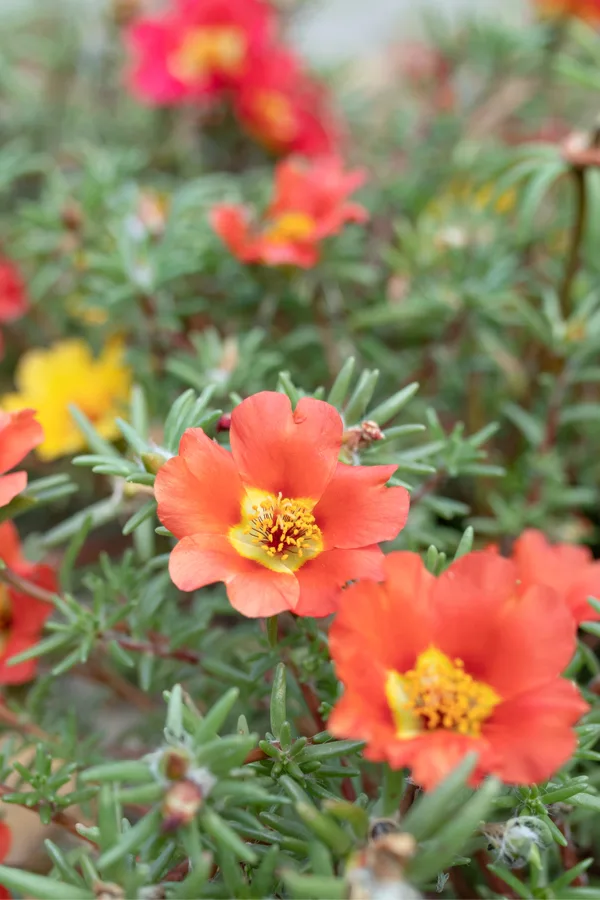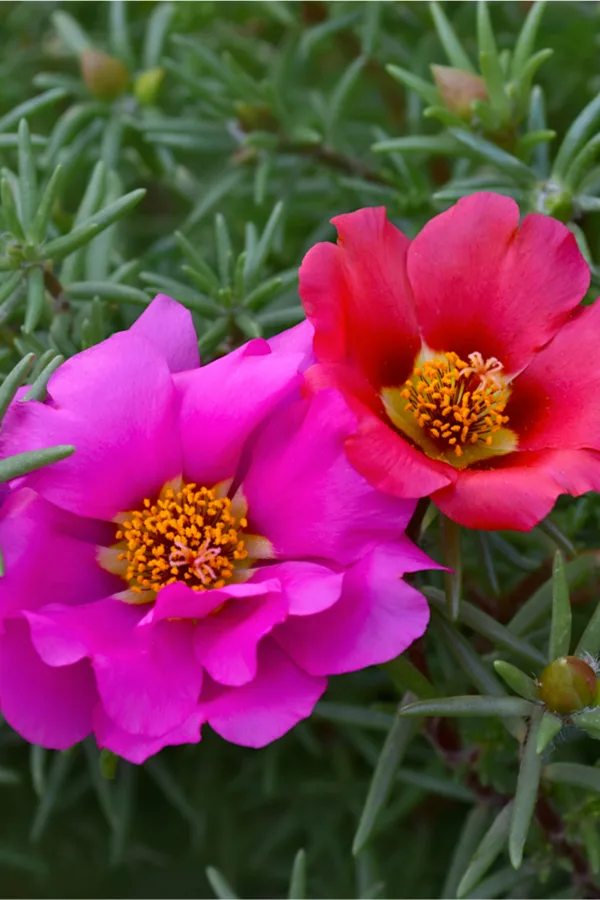Growing Portulaca in pots, containers or directly in your flowerbeds can add incredible beauty and color to your landscape – especially when you can keep it blooming strong all summer long!
Portulaca, also commonly referred to as Moss Rose, is a flowering annual that produces a flush of mini-rose style flowers on top of a low growing canopy of succulent foliage. Although it is an annual, it is a prolific self-seeder, and often comes back from seed year after year.
Although it has been around for years, Portulaca is gaining in popularity once again. One of the biggest reasons for that is its ability to perform well in containers and hanging baskets.

In bed spaces, Portulaca grows low to the ground and can be quite the choice as a ground cover or border plant. But when placed in containers and hanging baskets, the runners spill over the edges and trail down, making them perfect for creating big interest and color.
The color and style of blooms of portulaca all depend on the variety you grow. Blooms can be found in in a wide array of hues – from white, red, orange and violet, to yellow, pink and more. And those flowers can be found in single, double, or even semi-double styles!
Growing Portulaca – How To Keep Portulaca Blooming
Soil Types
One of the best attributes of growing Portulaca is the ease of planting. For starters, it doesn’t require a great deal of soil vitality to excel. Not only can it handle drought with ease, the plant actually thrives with less water.
But adding to its allure, Portulaca can also perform well in soils that are less than ideal. Portulaca prefers rocky to sandy style soils that drain well, but handles well draining potting soil great too.
It’s just one more reason they make for excellent container plants! (See: How To Create Great Potting Soil)

The one soil type that will cause an issue for Portulaca is clayish, thick, hard soils. Portulaca struggles when sitting in water or when its roots become saturated. When planting in these types of soil, always amend with plenty of compost. This helps to add in humus and increases the soil’s ability to drain well.
Planting Portulaca – How To Keep Your Portulaca Blooming
Location
Where you locate your plants will have a big impact on how and when they bloom. Portulaca is unique in that its flowers unfurl only when the sun or light is shining upon them.
The blooms of portulaca actually close at night, or whenever shade is present. In fact, they will even close up on a cloudy or rainy day until the sun reappears!
For this reason, planting them in partial or full shade will result in few to little blooming. The plant can survive in full shade, but it will be all foliage and no color. Instead, plant or place in an area that will receive at least 6 to 8 hours of full sunlight each day. The more sunlight they get, the more they will bloom!
Planting
One thing is for sure, Portulaca is extremely easy to plant. Whether planting directly into beds, or in containers and hanging baskets, it is best to start Portulaca from seed.

Although you can purchase or grow your own transplants, growing directly from seed is one of the best options. Not only is it less expensive, it also keeps the roots undisturbed, which can speed overall growth rates.
Allow the soil to warm before planting. Seeds will germinate quickly in soil that is at least 65°(F). Cooler soil will not only prevent germination, but cause the seeds to rot or damp off.
Plant seeds about 1/8th to 1/4 inch deep in the soil and lightly moisten the soil. In warm soil, seeds will usually germinate in five to seven days. Remember that Portulaca is better with less moisture than more. With this in mind, be careful not to overwater.
If you will be starting transplants indoors to place in hanging baskets or containers, start seeds about 6 weeks before your planting date. Just as with outdoor seed planting, be careful not to overwater seedlings when they germinate.
Maintaining – How To Keep Portulaca Blooming
The single biggest key to keeping Portulaca blooming all season long is proper water and sunlight. When planted in well draining soil and being watered properly, they should thrive as long the plants are getting at least 6 hours of sunlight.
When using as a trailing plant in hanging baskets or containers, plant your portulaca on the outer sides of the basket. This will allow them to trail over easily, but also keep them from getting too much water in the center portion.

As for fertilizer, Portulaca requires very little in addition to the nutrients available in the soil. A light, monthly application of a basic (5-5-5) slow-release granular fertilizer can help produce a bit thicker foliage and bloom set, but little more is needed or required. Product Link: 5-5-5 Fertilizer
Deadheading – How To Keep Portulaca Blooming
If there is one task that will improve your bloom frequency and intensity, it is regular deadheading! Deadheading is the practice of removing spent or decaying blooms.
This allows the plant to conserve energy for setting and producing new flowers, and not wasting it on trying to repair blooms that are fading. (See: How To Deadhead Annuals & Perennials)
Weekly deadheading of your plants will greatly improve and increase overall blooms. The longer old blooms remain, the more your plant will require time to replace them with new flowers.
Here is to growing Portulaca this year in your landscape, and enjoying its beautiful rose-like blooms in all their glory from late spring until your first frost!

Follow Our Facebook Page For Great Gardening Tips And Advice! This Is My Garden Facebook Page
This Is My Garden is a garden website created by gardeners, for gardeners. Jim and Mary Competti have been writing gardening, DIY and recipe articles and books and speaking for over 15 years from their 46 acre Ohio farm. They publish three articles every week, 52 weeks a year. Sign up today to follow via email, or follow along!
